If you surf the internet, watch TV, or read any of those in-flight magazines that are stuffed into the air-line seats, you have probably seen the magnetic flashlights that “never need batteries”. They are pretty cool, I’ll admit that. Built around the “move a magnet through a coil of wire” experiment that I learned as a kid in grade school, these flashlights produce light after a short period of “shaking the light”. How well do they work? Is one better than the next? If so, which one is? Plenty of questions but who has the answers?
Some of the “facts” I read in the flashlight ads would have me believe that some are so awesome that they are just short of a full blown Jedi light saber……or are they? It was time to put these claims to the test and see just how good they really were. Put up or shut up…..it was time to put their money where the light does shine!
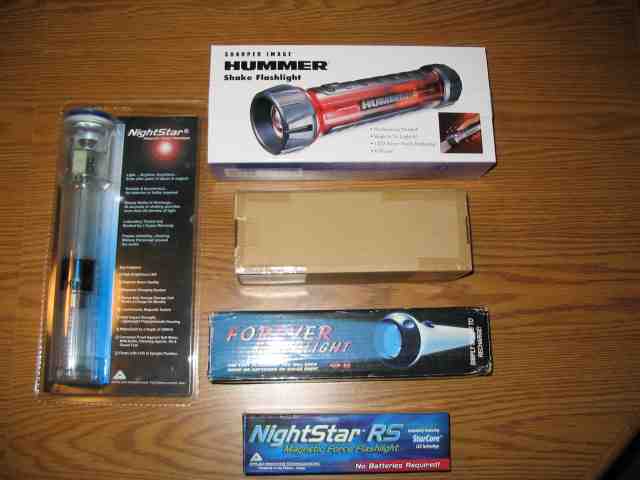
With the assistance of my magnetic flashlight supply guy, I soon had five likely candidates in front of me just begging to be put through their paces. Now mind you, I’ve never done any flashlight testing before, unless you count turning the switch on and off to see if the bulb works. But in my younger years, I worked in a Type II Naval electronics calibration laboratory as a certified Cal Tech. I felt confident I could come up with a battery of tests that would hopefully weed out the wanna-be flashlights and do so in an objective manner. No doubt, some parts of the evaluation would be subjective….but hey….not all things can always be quantified by a number. Sometimes, something just “looks better” than something else.
OK……so you now know what this roundup is all about. Time for you to get to know the contestants! I’ve included a few comments about each one. These comments were the result of my initial impression with the flashlight upon removing it from its package, reading the supplied directions, reading any available information provided on the package, shaking the light a bit and then turning it on….stuff like that. Yeah, it is not really very technical nor is it highly objective…..call it the flashlight’s chance to make a great first impression with the tester. And so, they are, in no special order:

Nightstar RS – 5 year warranty (ship to company at address provided), shake for 1 minute at 3 shakes/minute, this gives 8 minutes of light, recharging light takes about 30 seconds, good directions which also includes cautions about magnetic fields and erasing your credit cards, tapes, etc. It is lightweight, uses magnets at each end of the light to reverse the direction of the charging magnet (that is cool!). Not very noisy when you shake it. No lanyard attachment point. Flashlight is sealed and can not be opened. Has a rather unique rotary on/off switch…easy to manipulate. Lists patents.
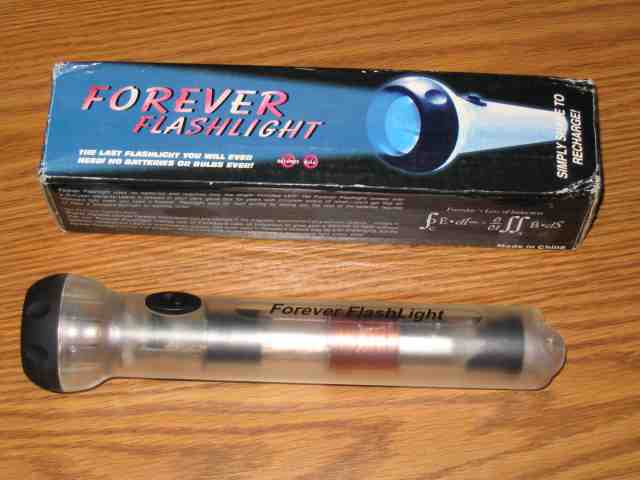
Forever flashlight – 1 year warranty (must ship back to company but no address is provided….what good is this?), 30 seconds of shaking gives more than 5 minutes of light, recharge by shaking 10 to 15 seconds every 2 to 3 minutes, good directions which also includes cautions about magnetic fields, etc. Noisy when shaking. Uses springs (the source of the noise) and rubber bumpers to reverse the charging magnet. Feels “clunky” in your handy. Has lanyard attachment point. Flashlight can be easily opened by turning black ring around lens (why?). I opened it and removed the contents for inspection. It has the worst soldering job, on the printed circuit board, of all the flashlights. Has a sliding on/off switch.

Everlast flashlight – no warranty indicated in documentation (I guess I am on my own?), 30 seconds of shaking gives up to 3 minutes of light, good directions which also includes cautions about magnetic fields, etc. Comes with a miniature version of itself (is this like a “Mini-Me” kind of thing?) Mini-me is virtually useless….shake it excessively to get a little bit of light. If I had a 6 year old child, I would give it to them so they could have a flashlight “just like Dad”. The flashlight can be easily opened by turning black ring around lens (why?). Not very noisy when you shake it. Has lanyard attachment point. Uses a push button switch that you must continuously press to remain illuminated.
The on/off switch just ruined the chances of my ever using this light for anything other than completing the tests in this roundup. There is no way I will hold the light (to keep the button pressed) while working on my Jeep at 1:00 AM with my remaining free hand. Sure….I could get some electrical tape and find a small rock and tape it over the switch to keep it pressed…..but that simply isn’t going to happen.

Nightstar – 5 year warranty (ship to company at address provided), 30 seconds of shaking gives 20 minutes of light, most complete directions of all (includes specs on depth, noise emissions, hazardous gas certification, marine certification, submersion, corrosion resistance, light output, etc.) Has lanyard attachment point. Flashlight is sealed and can not be opened. Uses magnets to reverse the direction of the charging magnet (that is cool, again!). Not very noisy when you shake it. Glow in the dark on/off switch. Feels “solid” in your hand. Clear plastic housing allows easy viewing which reveals surface mount components in use on the printed circuit board (that is ultra cool!). Very bright output. Lists patents. Has a sliding on/off switch.
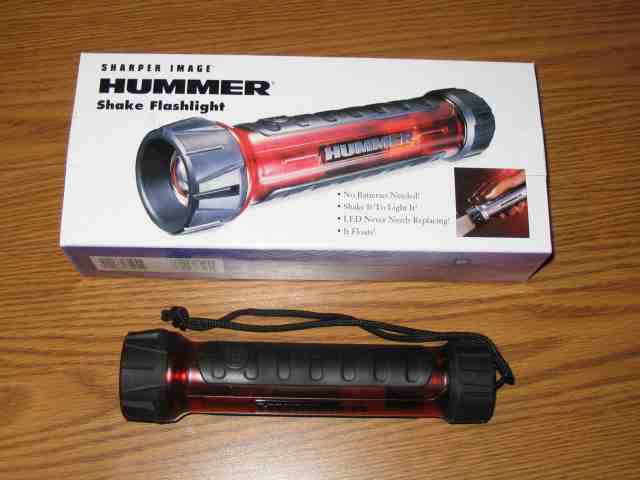
Hummer Shake flashlight – 90 day warranty (ship to company at address provided), 30 seconds of shaking gives more than 5 minutes of light, recharge by shaking 10 to 15 seconds every 2 to 3 minutes. Very big box to hold an average sized light. Rubber grips on body are nice. Comes with attached lanyard. Not too crazy about the push button on/off switch….hard to manipulate….can’t tell by “feel” when it goes on or off….must look at light for confirmation. Flashlight can be opened by turning black ring around base or lens (why?) but contents do not easily slide out. Uses rubber bumpers to reverse the direction of the charging magnet. Not very noisy when you shake it. Claims patent pending. (kind of late maybe?) Has a push on/push off switch.
Magnetic Flashlight Roundup
One of the tests I ran on all the flashlights included measuring the LED brightness and light duration. I didn’t have a lab full of sophisticated equipment but I wasn’t going to rely on the old “calibrated eyeball” method either. My best method I could come up with for performing a brightness comparison resulted in my acquiring a Gossen photography light meter from a friend and using it to measure the output of the various flashlights. I was not trying to determine the actual candle power output of the flashlight but merely wanted to be able to compare relative brightness using a consistent measuring method.

The brightness and duration test was performed in the following manner. Two identical height benches were positioned 6 feet from each other. On one bench, the Gossen light meter was positioned so that it would be directly illuminated by the flashlight under test. On the other bench, markings were placed on the bench surface to ensure accurate placement/alignment of the flashlight towards the light meter. The placement of the light meter was on or about the center of the light beam. A stop watch was used to time the duration of the illumination period. The test was conducted in an interior room with ambient light supplied by overhead fluorescent light fixtures.
All flashlights had seen prior use (charging and discharging) within the 24 hours preceding the brightness test. As such, none were completely discharged (this was verified prior to the start of the brightness test). Since all of the directions provided with the flashlights state the times required to recharge the flashlights, two charge times were selected and used on each flashlight during the test. The first charge cycle consisted of 2 minutes of “shaking” at the suggested 2-3 shakes per second. The second charge cycle, which immediately followed the first run of each flashlight, was limited to 1 minute of “shaking”, again using the suggested 2-3 shakes per second method.
It was also my intent, during this test, to try to discount any influence in LED brightness that may be a direct result of the storage capacitor’s long term storage “quality”. A higher quality electrolytic capacitor has less leakage than a lesser quality unit. If you were to fully charge a low quality capacitor and let it set for a period of time, you would find that the capacitor had self discharged to some level. To reduce that affect on this test, the flashlight to be tested was first charged and then immediately placed onto the test bench where the brightness and duration test was conducted. Once that phase of the test was completed, the same flashlight was recharged using the criteria for the second charging cycle. Again, it was immediately placed onto the test bench where the brightness and duration test was conducted. This testing process was applied to each flashlight.
I did not use a standard set of times while monitoring the duration of the light (ie. 1 min., 2 mins., 5 mins., 10 mins., etc.). Some of the actual times were fairly short while others were significantly longer. I believe the times noted will provide you with a good indication of the flashlight’s initial brightness (start of test) and the point where meter detectable light output ceased.
The units of measure for the light intensity values recorded in the tables below equate to absolutely nothing. There is no direct correlation between the numbers recorded and foot candles of light. It provides a means by which the light intensity of all flashlights, tested in the above manner, can be compared to each other.
Here are the results as I recorded them:
| Model | Test # | Time in mins. |
Brightness | Test # | Time in mins. |
Brightness | |
| Nightstar | 1 | 0 | 3+ (off scale) | 2 | 0 | 3 | |
| 3.5 | 3 | 2.5 | 2 | ||||
| 5 | 2.5 | 6 | 1 | ||||
| 12 | .5 | 9 | .5 | ||||
| 15.5 | 0 | 12 | 0 | ||||
| Nightstar RS | 1 | 0 | 2.5 | 2 | 0 | 2.5 | |
| 6 | .5 | 5 | .5 | ||||
| 8 | 0 | 7 | 0 | ||||
| Hummer | 1 | 0 | 3 | 2 | 0 | 3 | |
| 4 | .5 | 3 | .5 | ||||
| 6 | 0 | 5.5 | 0 | ||||
| Everlast | 1 | 0 | 2.5 | 2 | 0 | 2.5 | |
| 1 | 1.25 | 2.5 | .25 | ||||
| 4 | 0 | 4 | 0 | ||||
| Forever | 1 | 0 | 2.25 | 2 | 0 | 2 | |
| 1 | 1 | 1 | 1 | ||||
| 4 | 0 | 4 | 0 | ||||
The Nightstar was, without a doubt, the brightest and longest lasting model tested. The numbers proved it. Although the smaller size of the Nightstar RS may give you the initial impression that it is a lightweight contender, its number made a good showing which put it in 2nd place. Yes, the Hummer was initially a bit brighter than the RS, but its output faded to zero while the Nightstar RS continued for two more minutes.
As for the Everlast and Forever flashlights, the Everlast was a bit brighter initially compared to the Forever. They both turned in poor durations of just 4 minutes. Given that both were initially charged for two minutes but yet provided only four minutes of light, the owners of these two lights will certainly develop good arm muscles…..charging those lights is pretty good exercise. One other comment in regards to the Everlast, the switch was just plain stupid to mess with. Find a roll of tape, locate a nut in the garage of the appropriate size, charge the light, press the nut onto the switch and wrap tape around the flashlight, click on the stop watch, etc. Ridiculous!
Magnetic Flashlight Roundup
Float Testing

The float test was pretty straight forward. Turn on the light and drop it into the swimming pool (yes, I did it at night, just in case you were wondering). There are only 4 flashlights lit up (in the above picture) on account of the Everlast and its annoying switch. The Everlast was floating around with the rest, but I guess you could say it was in stealth mode. They all floated and that was what was being verified. The most buoyant flashlight was the Nightstar. This was determined by placing the flashlights on the swimming pool floor and then releasing them to rise to the surface. The Nightstar RS was the slowest riser, due to its compact size and small internal volume.
Waterproof Testing

How do you test a bunch of floating flashlights to see if they are waterproof? You put them in an inverted milk crate, set the crate on the 2nd step of the swimming pool, and then place a brick on top of it to ensure it stays put. This put them about 12″ under water….not much in terms of absolute pressure, but I rarely have more than a foot of water sloshing around in my Jeep anyway so I thought it was a valid simulation of real world conditions. I waited 90 minutes and removed the brick to retrieve flashlights.
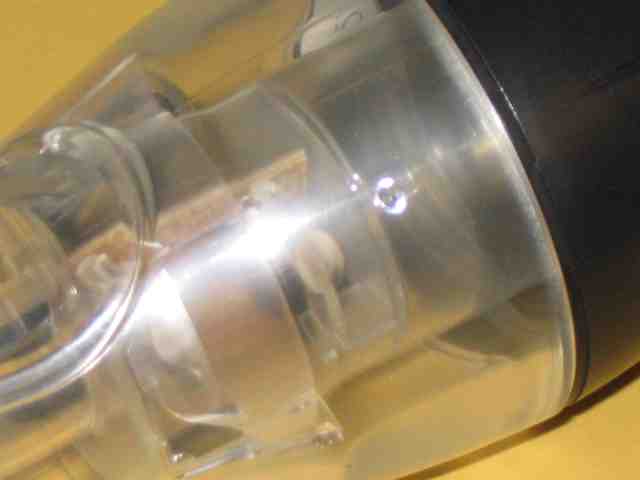
The Everlast flashlight picked up some water inside the housing. A handful of drops collected during the 90 minutes it was submerged.

The Forever flashlight allowed more water to enter into the housing than did the Everlast. It was not a huge amount but was noticeably more than what the other leaked.
The Nightstar, Nightstar RS, and the Hummer flashlights had no evidence of water entry into the housing.
Leak-down Testing
When I mentioned to my wife that I was going to do a leak down test, she thought I was heading back to the pool with the flashlights. Wrong! I wanted to test the quality of the flashlight’s storage capacitor. The capacitor stores the electrical energy that is generated by the magnet passing through the charging coil. If the capacitor is a quality component, you can charge the light today, use it for a little bit, and then toss it into your glove box. Some time later, when you use it again, the capacitor will still be charged and your light can be used immediately without the delay to recharge it….or a few quick shakes will top it off and you are ready to go. If the storage capacitor is a low quality unit, most or all of the capacitor’s charge will dissipate and you will have to recharge the flashlight from zero before using it. Depending on the capacitor, the leak-down rate can be minutes, hours, or days. If your flashlight goes many days between charges and still retains a charge, you have a pretty good light, in my opinion. In case you were wondering, the quality storage capacitor will drive the cost of the flashlight up. Low quality capacitors can be had for less money and so can show up in a cheap flashlight.
I should also mention that the storage capacity (measured in farads) of the capacitor will have an impact on the results of this test. A larger capacitor will hold a larger initial charge and so will last longer. If it is a quality component, it will experience only minor leak-down. This would be an ideal setup for a magnetic flashlight. On the other hand, a smaller storage capacitor with a faster leak-down rate is a recipe for a a poor performing flashlight. You will be shaking it a lot and it won’t hold the charge for very long.
I wasn’t sure just how long I should let the flashlights sit before doing the leak-down test so I decided to try the first test at about 30 hours. (I picked 30 hours because it also fit my schedule of things I was doing over the weekend.) Since I used a 2 minute charging cycle in the first run for the brightness and duration test, I thought it appropriate to use it again. That would provide me with an already established reference point by which to compare the flashlights. Each flashlight was dutifully shaken for 2 minutes and then set off to the side to “leak-down”.
Sunday afternoon rolled around and I found myself at the 30 hour mark. I was, however, not at the same location where I performed the brightness and duration test. I still had the loaner light meter so I setup a pair of test benches separated by the same distance I previously used. The only thing that differed from the first setup was the ambient light conditions….but that was not a real problem. Since I would be comparing the 5 flashlights to each other, it made little difference if the room was not lit the same as before since I still would be measuring the the LED output of each flashlight on the light meter at the same distance.
After the testing was completed, I charged the Nightstar for 2 minutes and then tested it to get a reference for initial brightness. Using this setup, it registered 2 on the light meter. Obviously, the ambient light at my second testing location was higher than it was at the first. Had there been less light, the initial brightness readings for the leak-down test would have been higher and the duration would have gone longer. But as I said, all the flashlights were tested in the same manner during the leak-down test so the numbers for each model are still valid.
Here are the results of leak-down test:
| Model | Time in mins. |
Brightness |
| Nightstar | 0 | 1.75 |
| 1 | 1.25 | |
| 2.25 | .75 | |
| 3.5 | .5 | |
| 5.5 | 0 | |
| Hummer | 0 | 1.25 |
| 1 | .5 | |
| 2.25 | 0 | |
| Nightstar RS | 0 | 1 |
| 1 | .5 | |
| 2.25 | 0 | |
| Everlast | 0 | 1 |
| 1 | .25 | |
| 2.25 | 0 | |
| Forever | 0 | 0 |
The Nightstar came out on top in the leak-down test. It retained more of its previous charge and continued to produce it for a longer period of time. The Hummer edged out the Nightstar RS, on initial brightness, by just a bit. The Forever model lacked enough charge to cause the light meter to move.
Power Switch
Given the variety of different on/off switches being used on the flashlights, I thought I would make a few comments about them. Some may say that this part of the evaluation is rather subjective and they are probably correct. But some of the information here is fact and that can not be disputed. So here is my take on the power switches being used.
| Model | Comments |
| Nightstar | Two position sliding switch which indicates switch position, without manipulation.
Switch is luminescent and a short exposure to room or sunlight allows it to glow for several hours. Switch does not penetrate housing so no leaking seals. Switch contains small magnet that moves into position to activate a small reed relay inside the body of the flashlight, closing the contacts that power the LED. |
| Hummer | Two position push button, push on, push off. Can not determine switch position without checking for light output. (can not determine if light is off or discharged without cycling the switch)
Appears that the switch penetrates the housing which could cause leaking. |
| Nightstar RS | Unique rotary switch that resists clogging from mud and debris.
Switch is luminescent and a short exposure to room or sunlight allows it to glow for several hours. Switch contains small magnet that moves into position to activate a small reed relay inside the body of the flashlight, closing the contacts that power the LED. Switch does not penetrate housing so no leaking seals. |
| Everlast | Momentary push button, push on, release to turn off. Must constantly hold switch in on position to use flashlight. Appears that the switch penetrates the housing which could cause leaking. |
| Forever | Two position sliding switch which provides switch position indication, without manipulation.
Switch does not penetrate housing so no leaking seals. Switch contains small magnet that moves into position to activate a small reed relay inside the body of the flashlight. |
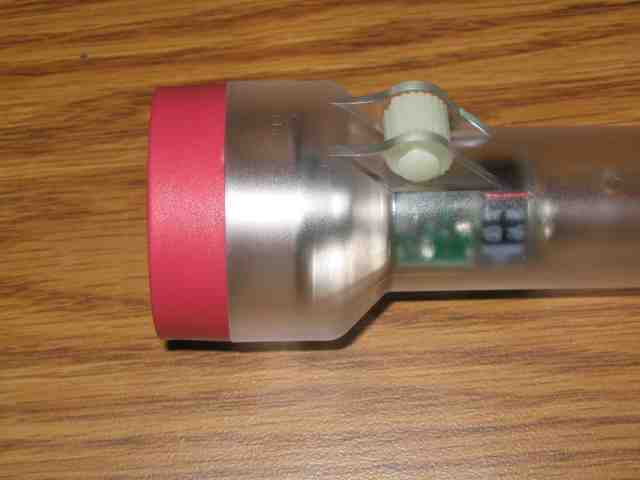
I like the rotary switch on the Nightstar RS the best. It is easy to actuate and provides positive feedback when you do. Its clog free design is just more gravy on the potatoes, in my opinion.
The luminescent switch on the two Nightstar models is a nice touch. They don’t make the switch work any better but it makes it easier to find the flashlight in a dark room, tent, Jeep, etc.
The Everlast switch is the worst choice for a flashlight, in my opinion. I could not tolerate a light that could not be turned on and then set down to allow me to work on something using both hands.
Drop Testing
The drop test was conducted from a shelf at 50″ above the concrete floor. The flashlights, one by one, were positioned at the edge of the shelf and nudged over the edge. Most did a 1/2 gator onto the floor but a few opened into a full pike, with a 3/4 rotation, just before impact. After impact, the light was checked to ensure it still had light output and the inspected for any signs of external damage. This was repeated 5 times. After the 5th drop, the lights were turned on and fully discharged. Each light was then charged for 30 seconds and checked again for light output. This last check was done to ensure the charging components were still functioning.
This was actually the last test performed on the flashlights. Since the survival rating of the flashlights was unknown, all other tests needed to come first so that they could be completed.
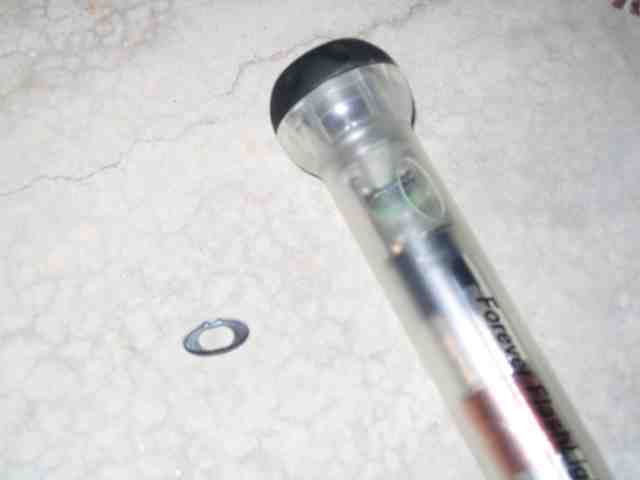
The first drop of the Forever light caused the power switch to detach itself from the housing. Since only one of the two pieces that came off could be located, the testing of this flashlight was terminated. The only way this flashlight could be checked was to place the charging magnet of another flashlight near it and actuate the internal reed relay.
One other incident repeatedly happened although the results were not as serious as those to the Forever flashlight. The Everlast flashlight’s rubber gasket that fits directly under the screw on ring that holds the lens in place, would partially dislodge itself each time the flashlight hit the concrete. While the retaining ring was screwed down tightly, it seems the case and ring would flex, from the impact, and cause the gasket to squeeze out in one or more places. After each impact, the retaining ring was released and the gasket placed back into position before the ring was again tightened.
The Nightstar, Nightstar RS, and Hummer lights suffered no apparent damage from the drop testing.
Beam Quality and Illumination Testing
Beam quality and illumination is pretty straight forward as far as testing is concerned. The pictures below were taken using a Cannon digital camera mounted on a tripod. The lens was set for f2.8 with a .4 second shutter speed in a relatively dark room. The flashlight was positioned just above the camera and directed towards an off-white wall, approximately 10′ away. The camera doesn’t quite capture everything the eye sees. However, it is consistent from one flashlight to the next and that is what the pictures reflect. Each flashlight was charged for 2 minutes prior to the picture being taken.
The second part of the test was conducted outside in the front yard and also near some shrubby that borders the front of the house. My dogs participated in this test. My black and white terrier was a good test subject as the light from the flashlights contrasted against her coat quite well. In other words, some of the flashlights made her pretty easy to see while others were not as good.
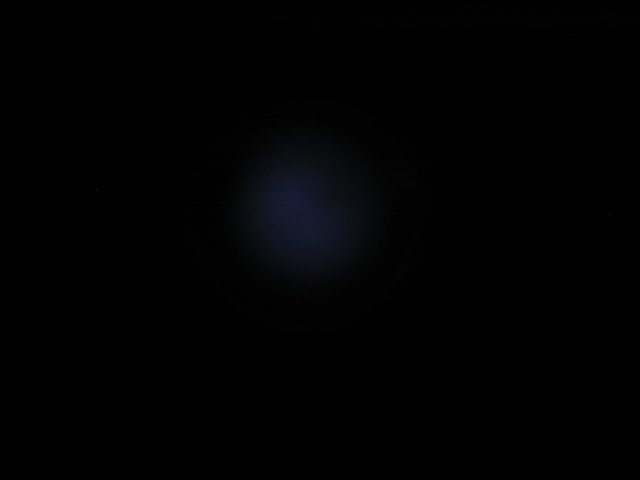
The Forever flashlight showed poorly in this test. It was notably dimmer than all of the other flashlights. The beam was nicely shaped except that there just wasn’t much of it for a picture. As for its illumination outdoors, it did no better.

The Nightstar RS flashlight provided a nicely defined beam. There were no distracting rings located outside of the major center beam. The warmer color (more yellowish than blue) illuminated outdoor objects better, including my dogs.

The Everlast flashlight provided a beam that was slightly out of focus. It appears that the LED itself is not quite centered within the flashlight’s reflector. It produces a round beam whose intensity is unevenly distributed throughout the beam. A large outer ring is visible around the center beam. This results from the design of the lens which has a “bubble” on it that looks as though it magnifies the center of the light beam. The beam is more bluish and doesn’t illuminuate the outdoors as well as some of the other flashlights.
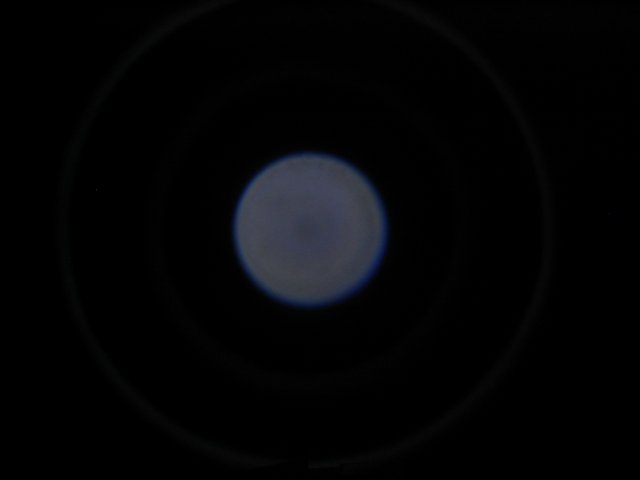
The Hummer flashlight has a lens design that closely matches the Everlast. Shining both of them on the wall, side by side, made almost identical patterns. It too suffers from the same distracting outer ring. It also has a bluish tint and so does not illuminate the outdoor subjects as well as those with a warmer light. The beam was more clearly defined and did not have the improperly positioned LED within the reflector.
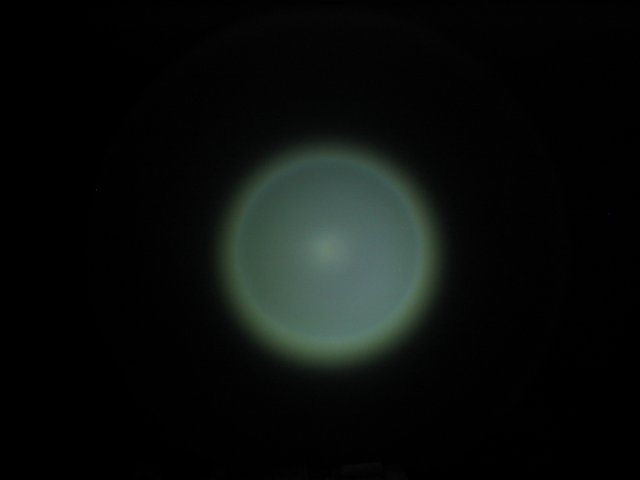
The Nightstar flashlight turned in the brightest picture of those flashlights tested. Its yellowish light worked well outdoors and finding the dogs in the shrubbery was not a problem. The beam is well defined and has no distracting outer rings. If you examine the lens, you will see the bubble, like on the Hummer, is absent. (that is a good thing)
Magnetic Flashlight Roundup
How did they do?
Putting these flashlights through their paces was interesting, not to mention somewhat enlightening (no pun intended). From what I witnessed, performance and product quality pretty much ran the entire spectrum. It didn’t take all that long to determine which were quality products and which were the wanna-bes.
One thing I noticed shortly after looking the lights over was that the two Nightstar flashlights display their US patent numbers while the others do not, although the Hummer light has a sticker on it that says a patent is pending. The similarity between some of these lights is down right amazing….all the way down to the magnetic on/off switch. Gee, I wonder just which flashlight is the patent infringing knockoff and which one is the legitimate product? OK, I’ll stop at this point since I never got my law degree and I’ll let the folks that did sort it all out.
Back to the flashlights……may I have the envelope please!
The 4th runner up is, without a doubt, the Forever flashlight. Its light brightness and duration times put it at the bottom of the list. During the leak-down test, it didn’t retain enough of a charge to register an indication on the light meter. While it passed the float test, it allowed more water entry than any of the other lights during the waterproof test. If this was the first magnetic flashlight I had ever encountered (as an uninformed consumer), I would be so disappointed with the entire idea that I would most likely tell my friends it was a waste of money and encourage them not to buy a magnetic flashlight. The fact that the switch broke the first time it was dropped rendered it non-usable.
The 3rd runner up position goes to the Everlast flashlight. Its performance in the brightness and duration test was second from last. It held the same spot in the leak-down test as well. It was the only other flashlight that saw water entry during the submersion test. Its on/off switch must be continuously depressed in order to use the light. Even if it had no other faults, the switch would keep it out of the top performer ranks due to this design choice. The drop test caused the gasket to dislodge which would not be a good situation in a wet environment.
The 2nd runner up position was grabbed by the Hummer flashlight. While I liked the rubber grips and overall feel of the light, it too suffered from less than acceptable light output duration times. The two minutes of shaking needed to generate 6 minutes of light is inefficient, in my opinion. Although its leak-down test made it the number two performer, the cooler bluish beam quality was too tight to reasonably illuminate an object at an appropriate distance for the flashlight.
The 1st runner up position was awarded to the Nightstar RS flashlight. Its overall performance ranked #2 only to its bigger brother. While the Hummer scored a bit higher on initial brightness testing, it didn’t have the staying power of the Nightstar RS. A fully sealed housing with no switch penetrations, surface mounted electronic components, luminescent switch, high beam quality….these were more than enough extras to position it ahead of the Hummer.
The winner of Magnetic Flashlight Roundup goes to the Nightstar flashlight, made by Applied Innovative Technologies, Inc. When it came to initial brightness and duration test, it was head and shoulders above all the others. Its duration numbers in the leak-down test were twice those of the Hummer. While it shares many of the same quality features of the Nightstar RS…..I like to think of it as the RS on steroids! It didn’t take long to pick up on the quality that goes into this model. It is a winner, no ifs, ands, or buts about it!
Summary
If you are looking for a quality compact unit that won’t break the bank but yet produces a good beam of light, pick up a Nightstar RS. It fits in my too small Jeep Wrangler glove box and it will most likely fit in yours. My wife, who now is pretty much up on all this flashlights stuff keeps eyeing the RS…..I am afraid to leave it unattended and so am forced to carry it to work. I know that if it sits at home for just a day, it will be reported as MIA once I get home.
If you want a light that charges fast and puts out more light for a longer time, then get your hands on a Nightstar. The sealed body (no screw rings, no gaskets, no switch penetrations) will keep out the elements. Its LED puts out a warm beam of light that lets you see better than anything tested. Simply put, it is THE magnetic flashlight that all others are compared against. I seriously doubt any will ever surpass it. Do it once and do it right…..get the Nightstar!
Good trails to you and remember to TREADLightly!
